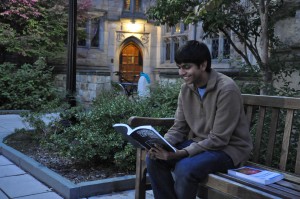
Take a stroll around Saybrook one day and odds are you’ll run into one of its most beloved Saybrugians: Akshay Gupta SY ’13. Although many in the class of 2013 affectionately call him by his pet name, “The Gupta,” chances are that his closest friends appreciate and are inspired by one of the most fundamental aspects of his personality—his fascination with particle physics. His love and dedication for physics, which he explained as “far more interesting than anything else I’ve ever studied,” is what drove him to the cutting edge of the field this summer: the European Organization for Nuclear Research (CERN) in Switzerland.
Gupta has been involved in physics research since his sophomore year of high school. During the summer of 2007, Gupta worked at Brookhaven National Laboratory (BNL), where he researched the impacts of cosmic radiation on Earth’s atmosphere and electromagnetic fields. During high school, Gupta presented his research from BNL to various science fairs, and won first place at the New York Science and Engineering Fair in 2008.
However, the young Gupta wasn’t just your Average Joe high school particle physicist; he was an entrepreneur, too. During his senior year, Gupta copyrighted and marketed “Hadron Hold ‘em,” a card game combining elements of poker with key concepts of particle physics; winning hands are cleverly named “Atomic Flush” and “Cosmic House.” Gupta marketed “Hadron Hold ‘em” to local high schools, claiming that it was an “enjoyable way to teach the basics of particle physics to high schoolers,” but quickly realized that “lots of local university physicists wanted to buy it for those late nights in the lab, too.”
During his freshman year at Yale, Gupta sat in on various graduate-level particle physics courses, and was introduced to various Yale physics researchers. After reviewing his credentials, especially “Hadron Hold ‘em,” Demers offered Gupta the opportunity of a lifetime—to work alongside her that summer at CERN in Switzerland, the home of the Large Hadron Collider (LHC), the world’s biggest atomic particle accelerator.
Gupta decided to work primarily with Sarah Demers, a Yale physics researcher, on a project involving tau leptons because he felt that it would have “a more immediate and powerful impact.” Gupta’s research goal was to understand and detect tau leptons, particles similar to electrons but with a larger mass, in LHC collisions; recognizing tau leptons in the collisions would help assert the existence of the Higgs boson, a theoretical atomic particle, and its ability to break, thus addressing one of the main concerns about the origin of the universe.
“I love CERN because it’s one of the few large organizations in the world that stresses basic science over applied science,” Gupta explained. “It really probes our understanding of the universe at the most fundamental level.” Apart from working with tau leptons in LHC collisions, Gupta was also able to work shifts in the ATLAS control room of the institute this summer, where he had the opportunity to converse with CERN Director Rolf Dieter-Heuer.
However, Gupta is quick to mention that budding European particle physicists have their fun, too. This July, Gupta traveled to Paris for Bastille Day, to Geneva for its music festival, and to Amsterdam to watch the FIFA World Cup Final with the Dutch. “He had the best summer of any Yale undergraduate,” said Vishal Maini SY ’13, one of Gupta’s eleven suitemates. “Definitely better than mine.”
After CERN, Gupta returned to New York and has continued to work remotely on a more independent project using the ideas of “super symmetry” to explain how the Higgs boson works. Gupta is on track to be published in a major particle physics journal within the coming year and is naturally excited about his future prospects. “CERN was the best experience of my life,” Gupta proclaimed. “I can’t wait to go back.”
